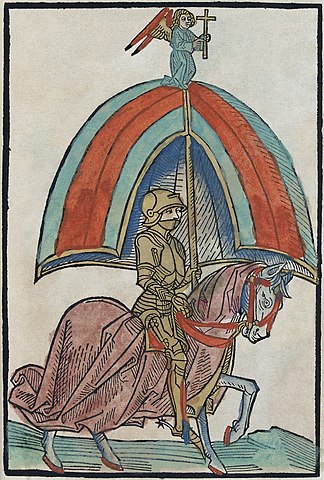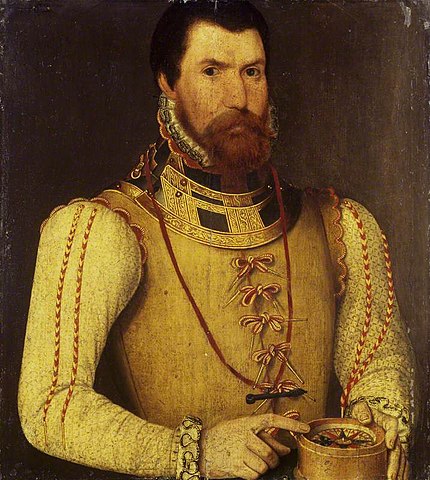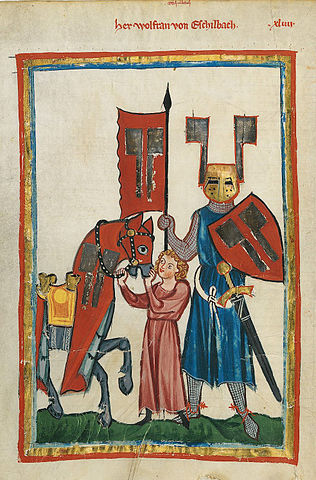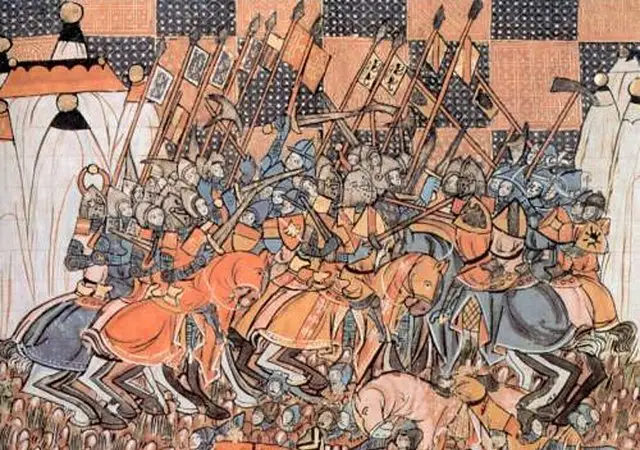
| Further Reading | The Top 5 Fun Facts About Medieval Knights |
Medieval knights wore well over 50 lbs. of heavy armor and were further covered with padded cloth and chainmail. Simply put, they were the tanks of the medieval battlefield. However, moving around and fighting all day long meant that the knight was always overheating, an action which could result in them passing out in the middle of battle from a heat stroke. To prevent that here are the 3 tricks that medieval knights would employ to remain cool while out in the field.
To keep cool while wearing heavy armor knights would do the following 3 things. First, they would wear heavy heavy padded cloth jackets that allowed hot air to escape out of the top cooling them down. Second, knights would often rotate out of battle to rest, take their armor off, and drink water. Third, most medieval battles would only last a couple of hours so the knights would only be in their armor momentarily.
Here at The History Ace, I strive to publish the best history articles on the internet. If at the end of this article, you enjoyed the content then feel free to subscribe and share the article around the web.
Without any further ado, here are the 3 things medieval knights would do to stay cool while wearing their heavy armor.
1: Medieval Knights Would Wear Heavy Cloth That Pushed Hot Air Out

One of the tricks that knights used to keep cool while wearing their heavy armor was actually to wear even more protection in the form of a heavy cloth garment or a gambeson.
You might think that this heavy cloth shirt would add more heat but it was designed to allow heat to rise out of the garment. As the knight’s body heated up the air between the garment and skin the hot air would rise and create a wind tunnel effect that would actually help cool down the knight. Many people are not aware of this and it would have been possible for a knight to fight for several hours before running the risk of overheating.
The reason this trick worked for cooling down the knight was that the human body can radiate heat faster than the sun can heat the armor. So long as the armor and gambeson are designed to allow air to pass between the knight’s skin and a layer of cloth then the knight would cool down. This is because the hot air would rise up through the knight’s thick cloth garment and escape out of holes on the top or through the neck opening.
Once the hot air left cold air from outside the knight would come rushing in to replace it. This in effect created a wind tunnel that was always replenishing the knight’s airflow and cooling them down! The best smiths would even design this into the armor they made for the wealthiest knights.
Both the thick garment and armor were specially designed to allow the heat from the knight’s body to rise upwards and escape out to the top of the knight’s armor. Historians for the past century have slowly discovered more about how intricate these suits of armor actually could be during the height of the middle ages.
Simply put, one of the major ways in which a medieval knight would cool down would be by wearing a thick cloth garment that was loose fitting. This loose-fitting garment would allow hot air to gather and then escape out the top which created a wind funnel of cold air coming underneath.
2: Knights Would Often Rotate Out of Battle to Rest, Take Their Armor Off, and Drink Water

One of the main ways that medieval knights cooled down while out on the field and wearing armor was by rotating out of battle to rest and get some water.
Most people get the wrong impression of how long a medieval battle would last. Often a medieval battle was only fought for a couple of hours and of this, there were often several ‘waves.’ Each of these waves was akin to a small skirmish between two groups and was often over after only a couple of minutes. Simply put, medieval soldiers did not fight for that long continuously. The knights in the medieval armies were no different.
What would end up happening what that a medieval knight would go to the front lines, fight for a couple of minutes, and then return to their squire to recover before going back out to battle. Here a knight’s squire would help them off their horse and give them some food and water while the knight rested. Often this food and drink for knights comprised of meat, bread, and some water/wine to wash it down.
It is important to note that most medieval knights would have not had their armor removed during this time. This was because getting a knight ready before a medieval battle would have taken several hours and involved several people. The most the medieval knight would take off during this downtime was their helmet but even this one piece of armor would have to be taken off by the squire.
After some time resting the knight would get back on their horse and begin to return back to the front line. This downtime between fighting would give medieval knights just enough time to cool down and was vital to preventing heat stroke in the knights. Simply put, one of the major ways in which medieval knights would cool down while wearing their armor was to return to their camp in between engagements and refresh. During this rest period the knight was attended to by their squire and gave them plenty of time to cool down before going back out to fight.
3: Most Medieval Battles Would Only Last a Couple of Hours So the Knights Would Only Be In Their Armor Momentarily

The average medieval battle only lasted a couple of hours at max and because of this the knight only had to wear their armor for a brief amount of time. While the medieval knight would wear their armor in the field it was only at the last moment right before the battle would begin that they would be attended to by their squire.
Contrary to popular belief most medieval battles were over long before the knight became exhausted and overheated from moving. This was because of the nature of medieval warfare. Remember the game of chess? Well, a medieval battle was more like this old game in the way that commanders of armies spent more time maneuvering around trying to find each other than they did actually fighting. If you are interested I wrote up an entire article on how long the average medieval battle lasted. (click here if interested)
While most medieval battles were over in an hour or two some did go for an extremely long time. A rare example of a medieval battle lasting longer than 2 hours was the Battle of Hastings in Norman England in 1066. This battle is on the longer end time lengths for medieval battles and it is estimated that both armies fought for 7 hours!
While that is a long battle the average medieval knight would only have to fight for about 10-15 minutes at a time. Because of this, they had plenty of time to cool down between engagements. Even with this cool-down time, they were only moving for about 10 minutes so they did not build up as much heat as people think.
Because of this, the medieval knight would simply cool down over time. While they were highly respected for their fighting ability they actually did not fight as much as the infantry did. Most medieval knights would have been from the nobility and provided a ‘presence’ on the battlefield instead of fighting. The knights that did fight would only fight for a small time window and because of this one of the main ways that they would cool down was by simply resting in between engagements.
As such the third way that a medieval knights kept cool while wearing their heavy armor was by only moving for a couple of minutes at a time. During the small combat engagements, they would heat up but quickly cool back down again after they were done 15 minutes later. This was because the knight would fight for the entire battle and they were held back in reserve to break the opposing infantry line and provide a shock presence.
Conclusion
There you have it; the 3 major ways in which a medieval knight would cool down while wearing their heavy armor.
Medieval knights are a fascinating topic, especially when you focus on their armor. It was extremely heavy but made to cover the entire body so the knight was actually agile and flexible. Because of this expert medieval smiths were always in high demand and nobles would commission the best suits of armor from them. These suits were even equipped to help cool down the knight by allowing hot air to escape from the knight.
I hope you enjoyed this article. Here at The History Ace I strive to publish the best history articles on the internet. If you enjoyed this article then consider subscribbing to the free newsletter and sharing around the web.
Further, you can check out some of the other articles below.
-
Was Medieval Armor Hot? 3 Ways The Knights Cooled Down

How did medieval knights stay cool while wearing their heavy armor? Well here are the 3 ways that they managed to stay cool even during combat


